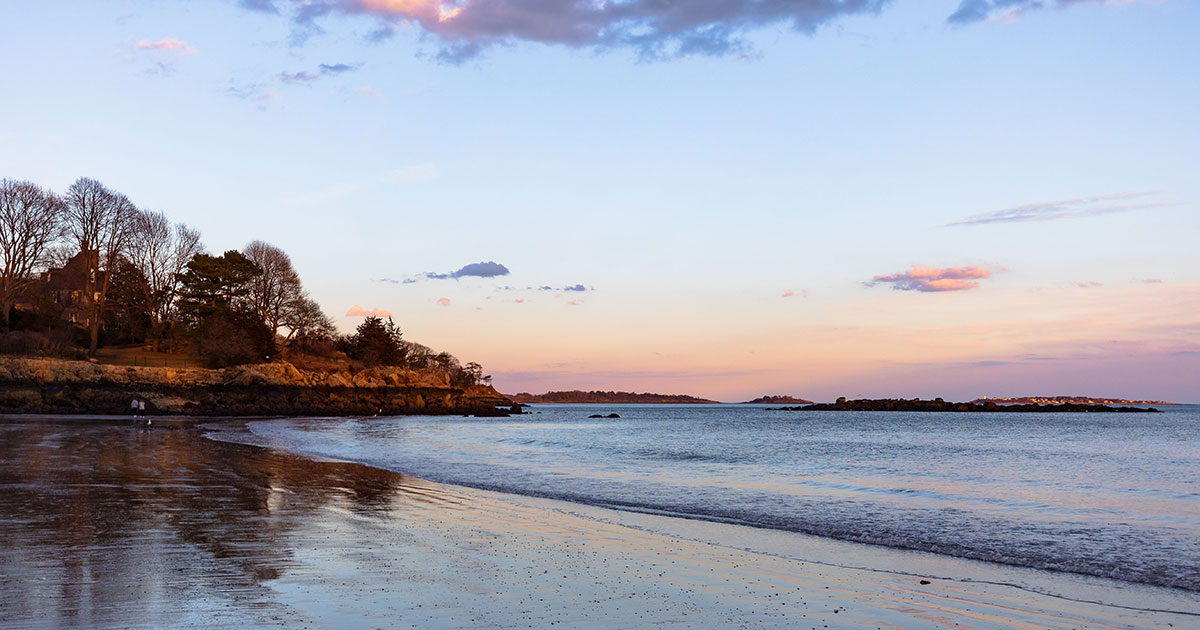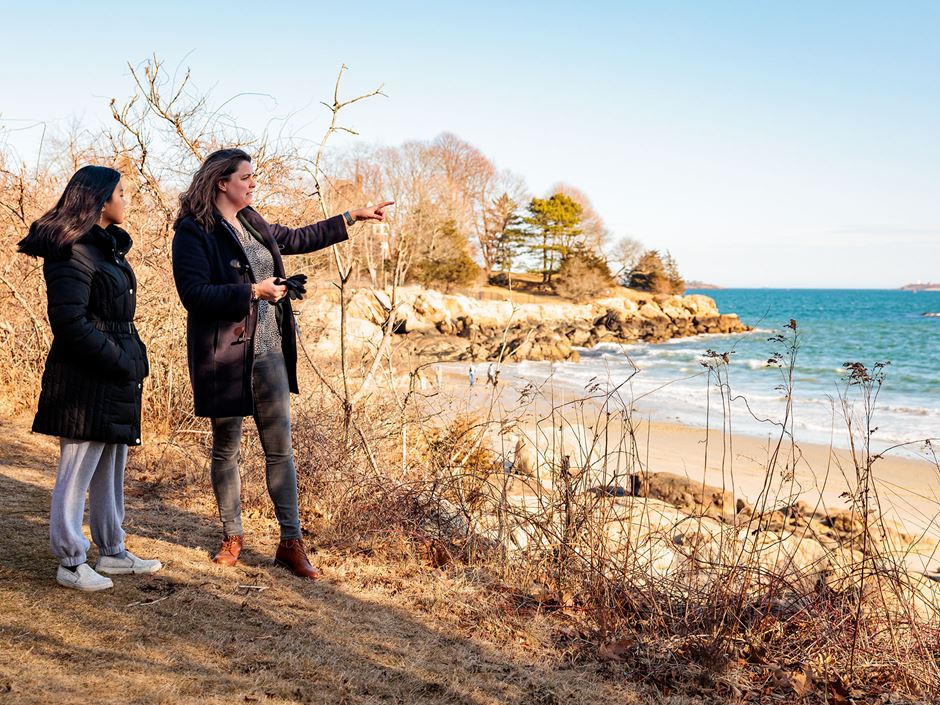Last spring, Associate Professor of History Elizabeth Matelski made national news when she uncovered a disturbing truth hidden in plain sight on the College’s scenic Mingo Beach. She discovered that the beach was named for Robin Mingo, an enslaved man who lived in Beverly in the 1700s.
“Legend has it, Mingo’s enslaver, Thomas Woodbury, promised the man’s freedom if the tides recessed enough for him to walk from the shore out to a rocky passage known as ‘Becky’s Hedge’ or ‘Aunt Becky’s Ledge’—a rare phenomenon, the story continues, that had occurred on the day of Mingo’s involuntary arrival in Beverly, Massachusetts,” said Matelski, who set out to understand where this narrative, which she calls the manumission myth, originated. (Manumission is the act of being freed from an enslaver, whereas emancipation is freedom through the abolition of slavery.)
With a funded sabbatical, she took the fall 2022 semester to really dig into the history of slavery on the land that is now Endicott property and learn more about the life of Robin Mingo. This time, she made discoveries so complex and intriguing that she is writing a nonfiction book about the legend that will read like a page-turning mystery.
One of Matelski’s goals for this stage in her project was to determine the date on which Mingo Beach received its name.
When she set off on sabbatical, she didn’t realize how many of the records she needed would be digitized and easily searchable. “I had a dream of going to archives and being surrounded by old pieces of paper. It wasn’t that at all,” she said with a laugh.
In fact, many of the sources were hidden in plain sight on the internet, popping up easily once archivists at the Peabody Essex Museum and Historic Beverly showed her where to hunt. She also dug deep into the Leventhal Map & Education Center digital collections at the Boston Public Library.
Over Zoom, Matelski glided her cursor over the shoreline of a 1781 map hand-drawn by Samuel Balch, a descendant of one of the original five settler families living in Beverly. “This little moon cove here is where Mingo Beach would be, but it’s not identified on this map,” said Matelski.
Turning to a nautical map from a few decades later in 1806, she said, “Here is where it’s marked as ‘Mingo’s Beach.’ A detail that I found really compelling is that the earliest maps refer to the stretch as Mingo’s Beach with a possessive.” The possessive is also added to nearby landmarks like Thistle’s House and Aunt Becky’s Ledge.

Ever since discovering the map, Matelski has chosen to refer to Mingo Beach as Mingo’s Beach to recognize that Robin Mingo, a formerly enslaved individual, had claim to the land.
“He purchased, owned, and sold his property. This isn’t just the naming of something after someone. This was Mingo’s land,” she said with a catch in her voice.
In fact, she was able to find an official Essex County land index that confirmed his purchase of Mingo’s Beach on January 2, 1728, a property Matelski describes as “a thin sliver of land.” The property had been a common cow pasture later divided into three parcels and sold. Per Matelski, it is likely that Mingo was previously forced to work as an enslaved person chopping wood, making hay, or bringing livestock to graze on the very land which ultimately became his own in freedom.
It is powerful that he ultimately bought the land for himself—though that achievement remains overshadowed by the cruelty of slavery and how it deprived him and others of their freedoms.
The discovery that came next was remarkable. When Matelski researched the timeline of Mingo’s life, she discovered conflicting reports about his date of death. The manumission myth described his death as taking place in 1774, but the numbers didn’t add up. Turns out, two men went by the name of Robin Mingo.
“We might think that is a super unique name, but it’s actually not,” Matelski said. “There is a tradition of naming enslaved children by the last name of their enslaver. Others were African ‘day’ names, signifying the day on which they were born. Mingo is a common name shortened from Domingo, or Sunday. Robin was also a popular first name for the first generation of enslaved Africans.”
One Robin Mingo died in 1748. He is the Robin Mingo who is the subject of the legend, said to have been challenged by his enslaver, Thomas Woodbury, to walk to his freedom, and about whom Matelski is writing her book. The first formal record of his life begins with his 1707 marriage to Deborah Tailer. He purchased land in 1728, lived there in an existing house on the property, and sold the land in 1747, the year before he died.
But the other Robin Mingo died in 1774, still enslaved. There is very little additional documentation about him.
There are no records of either man’s birth or passage to New England on slave ships, likely bound from Barbados. “People are being brought in handfuls on ships just like rum, molasses, or anything else that would have come from the West Indies,” she explained.
The truth, Matelski said, “is like a children’s game of telephone that got twisted, manipulated, and misinterpreted over time, until it became solidified.”
It is for this reason that she tells her students that when the primary sources that can answer a question about history are available, they have an ethical responsibility to track them down.
She’s used these primary sources to pin the location of Robin Mingo’s home on the property and wants to obtain grant funding to use a ground-penetrating radar on Mingo’s former land to look for the original foundation.
There is so much more left to unearth, but in the meantime, Matelski is speaking up for Robin Mingo—and the land’s history of slavery—to be publicly acknowledged as Mingo’s Beach.
“I want to see signage that marks Mingo’s Beach, shares Robin Mingo’s story, and also the wider legacy of slavery on the North Shore,” she said.
